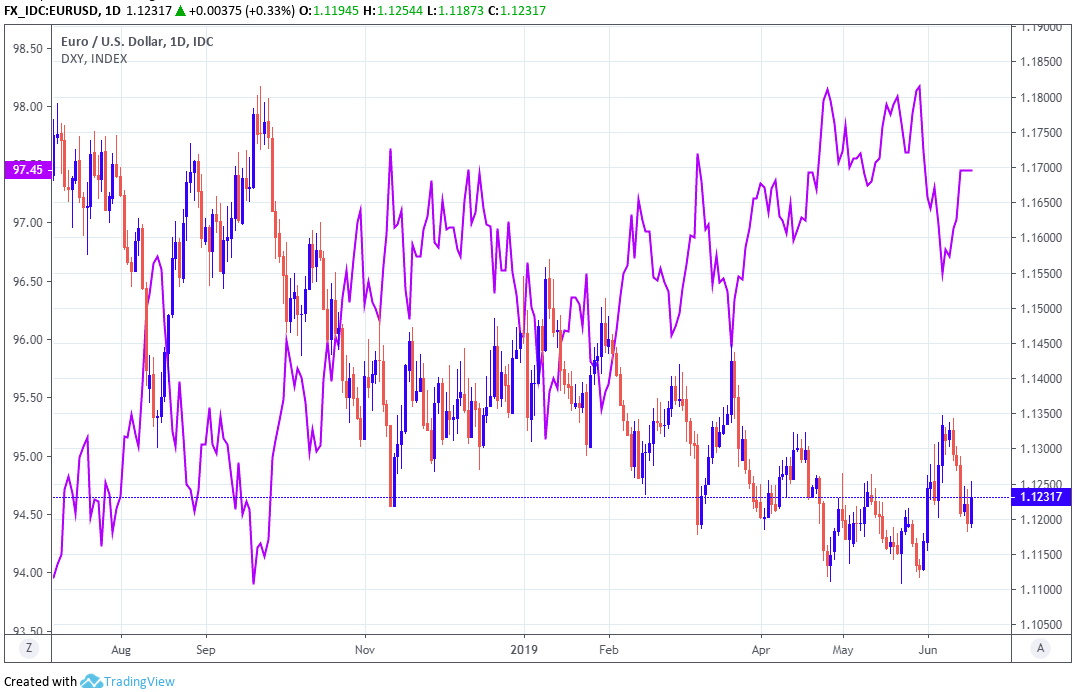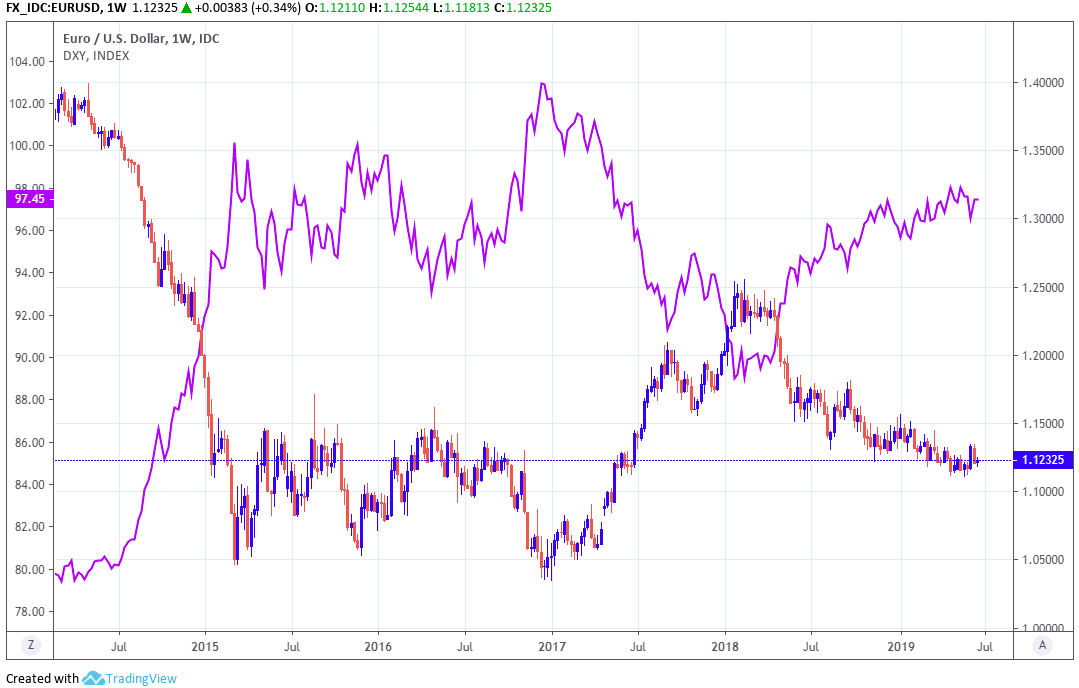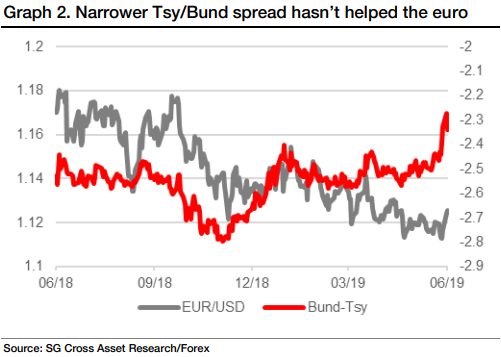EUR/USD Forecasters Still Divided over Direction into Year-end
- Written by: James Skinner
 © European Central Bank, reproduced under CC licensing
© European Central Bank, reproduced under CC licensing
- UBS downgrades EUR forecasts, upgrades outlook for USD.
- Sees go-slow economy weighing on EUR as the USD runs ahead.
- Says Fed rate cuts enough to lift EUR, as ECB also looking to cut.
- Marks break with other European lenders, who still eye EUR upside.
- ING, Societe Generale and Commerzbank all look for EUR gains in 2019.
The Euro has fallen nearly one percent against the Dollar this week but steeper declines lie ahead according to analysts at UBS, who're looking for the single currency to reach a near-three-year low before the end of 2019, although others still see gains ahead for Europe's unified unit.
UBS' reasons for downgrading its Euro-to-Dollar rate forecasts are twofold in that the Swiss banking giant now expects the Dollar to go on rising for longer than was previously the case, and it also sees a go-slow performance from the Eurozone economy holding the Euro down.
The Federal Reserve is widely expected to cut its interest rate later this year, which many other analysts have previously suggested would bring an end to an 18-month long rally by the Dollar. In turn the consensus has been for the Euro-to-Dollar rate to rise notably by year-end.
"This, however, does not imply EUR upside," says Bhanu Baweja, deputy head of macro strategy at UBS. "The ECB has also signalled a disposition to ease further if acute downside risks materialise, which would offset Fed easing to some extent."
The bank says the most important factor in determining the outlook for the U.S. Dollar, and by implication the Euro-to-Dollar rate, is the difference between economic growth in the U.S. and that seen elsewhere in the world. And that difference still favours a stronger-for-longer Dollar, and lower Euro.

Above: Euro-to-Dollar rate at daily intervals, alongside the Dollar Index (purple line, left axis).
Eurozone economic growth picked up from 0.2% to 0.4% in first-quarter of 2019 but surveys have since suggested strongly that the economy turned lower again at the start of the second quarter. Official data for the three months to the end of June won't be available until mid-August.
"The European economy has failed to bounce as we expected; the dollar's unique position as a high-carry 'safe-haven' will take time to erode; trade tensions have resurfaced; and political risk events in Europe are lingering in Q3 and Q4," Baweja writes, in a note to clients.
The Eurozone's early 2019 performance came hard on the heels of a disappointing 2018 year where GDP growth decline from 2.3% to 1.8%. Growth fell by half in the latter part of 2018, with third quarter GDP growth declining from 0.4% to 0.1% and then coming in at only 0.2% in the final quarter.
Meanwhile, U.S. GDP growth rose from 2.2% in 2017 to 2.9% during 2018, although the economy was helped along by a significant package of tax cuts from the Trump White House.
"Convergence to fair value is likely to be a much more drawn-out process than we were expecting," Baweja says. "The key to this is to be found in sluggish Eurozone growth, as re-convergence at lower growth levels will not do the trick."

Above: Eurozone economic indicators. Source: UBS Global Research.
These growth differentials matter to the Euro-to-Dollar rate because they facilitate a continued large gap between interest rates in Europe, which are at zero or below, and those in the U.S. which reached 2.5% in December 2018 after the Fed lifted its cash rate for the fourth time that year.
Changes in rates are only normally made in response to movements in inflation, which is sensitive to economic growth, but impact currencies because of the influence they have on capital flows and their allure for short-term speculators.
Capital flows tend to move in the direction of the most advantageous or improving returns, with a threat of lower rates normally seeing investors driven out of and deterred away from a currency. Rising rates have the opposite effect.
"We are revising our EUR/USD forecasts lower to 1.09 and 1.15 by end-2019 and end-2020," Baweja writes. "Macro convergence to lower growth levels is unlikely to offer much solace for EUR. Fed easing can only boost EUR if it takes place in a low volatility environment, and only to a fairly limited extent."
UBS has now downgraded its earlier forecast of 1.20 for year-end 2019 to just 1.09, which would be the Euro's lowest level since May 2017. At the same time, it's lifted forecasts for the Dollar index, which is now expected to end 2019 at 100.2, up from 97.19 Wednesday and ahead of UBS' earlier forecast of 92.5.

Above: Euro-to-Dollar rate at weekly intervals, alongside the Dollar Index (purple line, left axis).
UBS' forecasts mark a break with other European lenders, many of whom are still looking for the Euro-to-Dollar rate to rise in 2019. Societe Generale, Commerzbank and ING all project the single currency will rise before year-end.
"We doubt EUR/USD is able to take advantage of the soft dollar environment," says Chris Turner, head of FX strategy at ING. "The ECB looks very close to easing again – potentially in September with a deposit rate cut and re-starting asset purchases geared more towards corporate debt. Brexit and Italian politics suggest EUR/USD may remain trapped in a 1.10-15 range until year-end."
ECB President Marion Draghi said in a landmark address from the Portuguese city of Sintra this week that if inflation does not show signs of picking up sustainably toward the bank's target of "close to but below 2%" then additional stimulus for the Eurozone economy could be required.
This could mean the interest rate environment soon becomes more disadvantageous to the Euro, which might weigh on the single currency if not accompanied by a pickup in economic growth that offers the market hope of higher inflation and interest rates further down the line.
ING says those interest rate cuts, an October 31 deadline for the UK to approve the EU withdrawal agreement or leave the bloc without formalising its exit and the possibility of a final quarter clash between Italy and the European Commission over 2020 spending plans will constrain the Euro.
But the bank is still looking for the Euro-to-Dollar rate to end 2019 at 1.15. Currency analysts at Societe Generale are even more optimistic.

Above: Societe Generale graph showing EUR/USD alongside German-U.S. bond yield differential.
"Beset by weak growth, held down by negative short- and long-term interest rates and a central bank that is likely to be forced into further easing of one kind or another, the euro still lacks home-grown support," says Kit Juckes, chief FX strategist at Societe Generale. "Absent home-grown support, a euro bounce is dependent on weakness elsewhere. The dollar is now very overvalued, and as growth slows and the Fed embarks on an easing cycle, that is likely to be the main source of euro strength."
Juckes says the Euro is likely to finish 2019 at 1.16 but that gains will come from Dollar weakness and not Euro strength. This is very similar to the view propounded by the analyst team at Germany's Commerzbank.
"We have had to adjust our EUR-USD forecast to the downside– in particular until year-end 2019. We nonetheless continue to expect a rise in EUR-USD levels – but now mainly from 2020 onwards. Why do we remain optimistic for EUR-USD? The most convincing reason is the Fed’s monetary policy – and that will remain the case," says Ulrich Leuchtmann, head of FX strategy at Commerzbank, in a recent note to clients.
Leuchtmann says Federal Reserve interest rate cuts will make the U.S. Dollar's current lofty valuation increasingly unsustainable during the months ahead, which should eventually result in an upward turn for the Euro-to-Dollar rate.
Commerzbank forecasts the Euro will end 2019 at 1.16 against the Dollar and that it'll rise to 1.24 in 2020.

Above: Commerzbank Euro Forecasts.
Time to move your money? Get 3-5% more currency than your bank would offer by using the services of foreign exchange specialists at RationalFX. A specialist broker can deliver you an exchange rate closer to the real market rate, thereby saving you substantial quantities of currency. Find out more here.
* Advertisement




